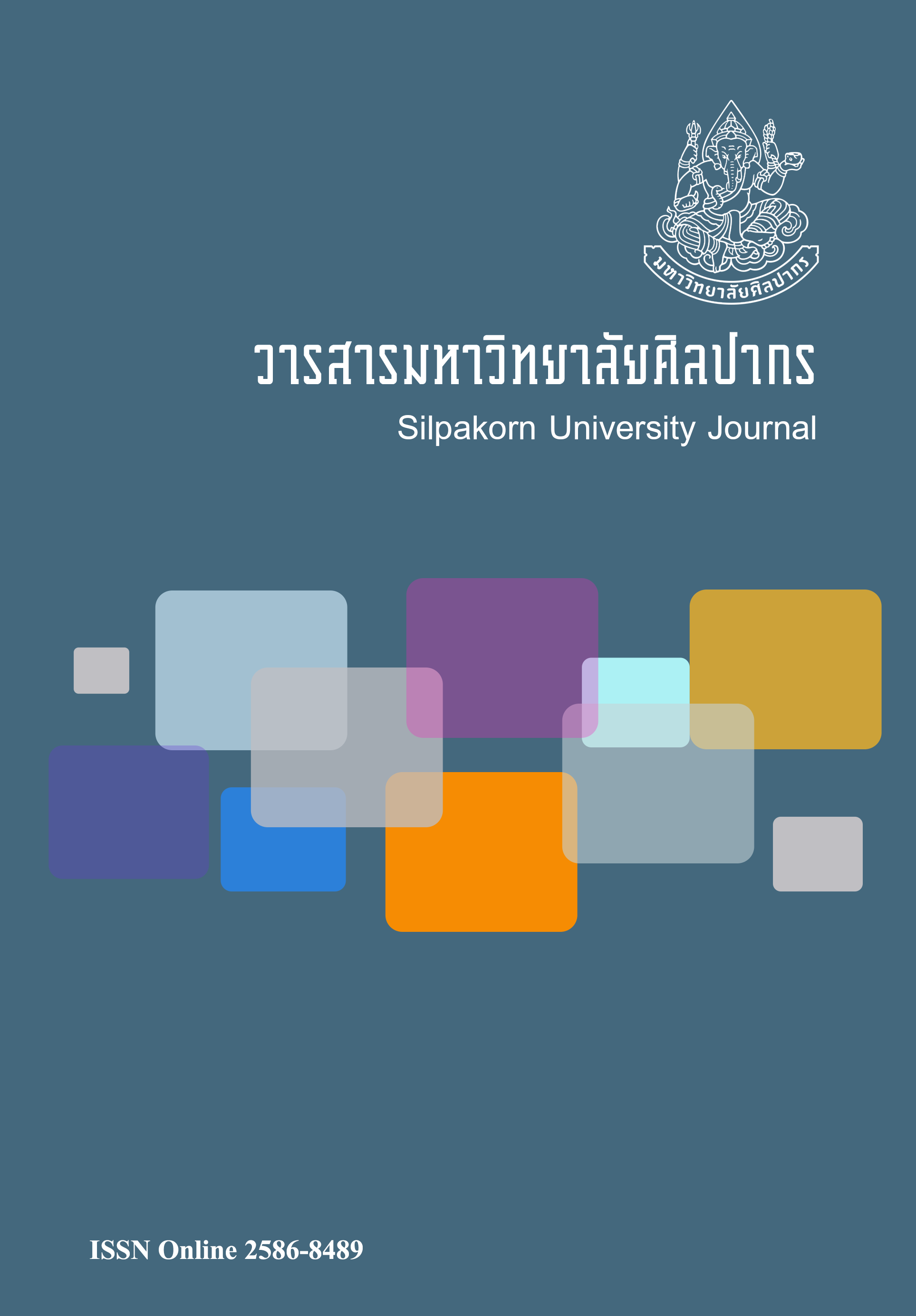การศึกษาศักยภาพแหล่งท่องเที่ยวเกาะเต่า จังหวัดสุราษฏร์ธานี เพื่อเป็นแนวทางในการพัฒนาการท่องเที่ยวอย่างยั่งยืน (A study on potential of tourist attractions on Tao Island in Surat Thani Province as a guideline to promote sustainable tourism)
Main Article Content
Abstract
งานวิจัยเรื่องการศึกษาศักยภาพแหล่งท่องเที่ยว เกาะเต่า จังหวัดสุราษฏร์ธานี มีวัตถุประสงค์เพื่อการศึกษาพฤติกรรมความพึงพอใจต่อศักยภาพแหล่งท่องเที่ยวเกาะเต่า จังหวัดสุราษฏร์ธานี และเสนอแนวทางการพัฒนาการท่องเที่ยวอย่าง โดยเป็นการวิจัยแบบผสมผสาน ที่ลักษณะการเก็บรวบรวมข้อมูลเชิงปริมาณและคุณภาพ โดยประชากรและกลุ่มตัวอย่างที่ใช้ในการวิจัย ได้แก่ นักท่องเที่ยวชาวต่างชาติ ผู้วิจัยเลือกเทคนิคการสุ่มตัวอย่างโดยไม่คำนึงถึงความน่าจะเป็น (Non-Probability) และใช้วิธีการสุ่มแบบเฉพาะเจาะจง (Purposive Sampling) ในการเก็บข้อมูลเชิงปริมาณ จำนวน 381 คน โดยใช้การเทียบตารางของ (Krejcie & Morgan) และการสุ่มตัวอย่างแบบลูกโซ่ (Snow ball) ในการเก็บข้อมูลเชิงคุณภาพจำนวน 30 คน ใช้สถิติในการวิเคราะห์ข้อมูลเชิงปริมาณ ได้แก่ ค่าเฉลี่ย ร้อยละ ส่วนเบี่ยงเบนมาตรฐาน และใช้การวิเคราะห์เนื้อหาที่เป็นการสรุปเป็นรายประเด็นในการสรุปข้อมูลเชิงคุณภาพ ผลการวิจัยพบว่านักท่องเที่ยวชาวต่างชาติมีความพึงพอใจด้านศักยภาพแหล่งท่องเที่ยว (1) ความพึงพอใจต่อศักยภาพของแหล่งท่องเที่ยวด้านความประทับใจมากที่สุด โดยพบว่ามีกิจกรรมที่ทำให้เพลิดเพลินกับการชมแหล่งท่องเที่ยว (2) ความพึงพอใจต่อศักยภาพของแหล่งท่องเที่ยวด้านกิจกรรมการท่องเที่ยว โดยพบว่าการจัดกิจกรรมที่มีเหมาะสมมากที่สุด (3) ความพึงพอใจต่อศักยภาพของแหล่งท่องเที่ยวด้านสิ่งดึงดูดใจในการท่องเที่ยว โดยพบว่ามีความงดงามของแนวปะการังมากที่สุด (4) ความพึงพอใจต่อศักยภาพแหล่งท่องเที่ยวด้านสิ่งอำนวยความสะดวก โดยพบว่า จำนวนร้านอาหารมีจำนวนเพียงพอมากที่สุด (5) ความพึงพอใจต่อศักยภาพแหล่งท่องเที่ยวด้านสิ่งแวดล้อมและการส่วนร่วมของคนในชุมชน โดยพบว่า ผู้ประกอบการมุ่งคำนึงถึงสภาพแวดล้อมและวัฒนธรรมมากกว่าประโยชน์ส่วนตนมากที่สุด และ (6) ความพึงพอใจต่อศักยภาพแหล่งท่องเที่ยวด้านการเข้าถึงแหล่งท่องเที่ยว น้อยที่สุดโดยพบว่า มีการประชาสัมพันธ์อย่างต่อเนื่อง แต่สิ่งที่ต้องพัฒนาคือสภาพเส้นทางของการเดินทาง
This research aimed to study tourist attraction potential of Tao Island in Surat Thani Province, specifically to study tourist’s behavioral satisfaction with the tourist attraction potential of Tao Island and to propose guidelines for tourism development. This is integrated (mixed) research, using quantitative and qualitative methods in data collection. The sample population for this research is foreign tourists who visited Tao Island. Based on Krejcie & Morgan Table, 381 samples were chosen, using the purposive sampling method with non-probability for quantitative research. 30 samples were chosen, using the snowball sampling method for qualitative research. Statistics for quantitative analysis comprised mean, percentile, and standard deviation. Additionally, content analysis was conducted to analyze data and arrive at issue summary for qualitative analysis. The results of this study in terms of foreign tourists’ satisfaction towards tourist attractions are as follows. 1) Regarding impression, tourists were mostly satisfied with potential of the tourist attractions; it was found that there were activities which rendered the visit entertaining. 2) Regarding tourism activities, tourists were mostly satisfied with suitable activities provided. 3) Regarding tourist attractions, tourists were mostly satisfied with the beauty of the coral reefs. 4) Regarding facilities provided, tourists were mostly satisfied with sufficient number of restaurants. 5) Regarding environment and participation of the locals, tourists were mostly satisfied with the fact that entrepreneurs focused more on the environment and culture than their personal benefits. And 6) The least satisfactory aspects was tourist accessibility; it was found that the public relations kept people informed continually, but they still need to develop and improve transport routes.
Downloads
Article Details
References
Barbosa, L. G. M., Falcão de Oliveira, C. T., & Rezende, C. (2010). Competitiveness of tourist destinations: the study of 65 key destinations for the development of regional tourism. Revista De Administracao Publica, 44(5), 1067-1095.
Chatchakul, N. (2012). Tourism industry (อุตสาหกรรมการท่องเที่ยว) (4th ed.). Bangkok: Chulalongkorn University.
Chemnasiri, N. (2012). Development of agriculture tourism (การพัฒนาแหล่งท่องเที่ยวเชิงเกษตร) (1st ed.). Bangkok: Physics center.
Chuamuangphan, N. (2015). Professional knowledge for tourist guide and services in tourism industry (ความรู้เฉพาะอาชีพมัคคุเทศก์และการบริการในอุตสาหกรรมท่องเที่ยว) (1st ed.). Bangkok: Sukhothai Thammathirat Open University.
Department of National Park, Wildlife and Plant Conservation. (2015). Koh Tao (เกาะเต่า) [Online]. Retrieved July 1, 2015 from https://park.dnp.go.th/visitor/nationparkshow.php?PTA_CODE=9143
Department of Tourism. (2014). Tourist statistics (สถิตินักท่องเที่ยว) [Online]. Retrieved July 1, 2015 from https://newdot2.samartmultimedia.com/home/listcategory/11/216
Esichaikul, R. (2012). Introduction to tourism and tourism industry (การท่องเที่ยวและอุตสาหกรรมท่องเที่ยว) (6th ed). Bangkok: Sukhothai Thammathirat Open University.
Hanthong, S. (2000). The potentiality of tourism management in Phatthalung Province (ศักยภาพการจัดการการท่องเที่ยวจังหวัดพัทลุง). Master’s dissertation, National Institute of Development Administration, Bangkok, Thailand.
Jittangwattana, B & Srikampa, P. (2014). Sustainable tourism development (การพัฒนาการท่องเที่ยวแบบยั่งยืน) (2nd ed.). Bangkok: Thammasan.
Keosuriya, R. (2013). Principles of sustainable tourism management (หลักการจัดการการท่องเที่ยวอย่างยั่งยืน) [Online]. Retrieved March 12, 2016 from https://lib.dtc.ac.th/article/tourism/0007.pdf
Kozak, M., & Rimmington, M. (1999). Measuring tourist destination competitiveness: conceptual considerations and empirical findings. Hospitality Management, 18: 273-283.
Krejcie, R. V. & Morgan, D. W. (1970). Determinining sample size for research activities. Educational and Psychological Measurement, 30(3), 607-610.
Ministry of Tourism and Sports. (2016). The suitability of the tourism development zone and listening to opinions on tourism development planning. Bangkok and the South Sea Islands (Koh Samui, Koh Phangan and Koh Tao) (โครงการศึกษาความเหมาะสมในการประกาศเขตการพัฒนาการท่องเที่ยว และการรับฟังความคิดเห็นในการกำหนดเขตพัฒนาการท่องเที่ยว กรุงเทพมหานครและหมู่เกาะทะเลใต้ (เกาะสมุย เกาะพะงัน และเกาะเต่า) (1st ed.). Bangkok: Ministry of Tourism and Sports.
Munglun, P. (2011). The potentiality of floating market tourism in Nonthaburi for tourism resources management (ศักยภาพแหล่งท่องเที่ยวตลาดน้ำในจังหวัดนนทบุรีเพื่อการจัดการทรัพยากรการท่องเที่ยว). Master’s dissertation, Thammasat University, Bangkok, Thailand.
Ployrungroj, R. (2015). Tourist behavior (พฤติกรรมนักท่องเที่ยว) (1st ed.). Bangkok: Odeon Store.
Song, H. (2010). Tourism demand modelling and forecasting: how should demand be measured?. China: School of Hotel and Tourism Management.
Surat Thani Province. (2014). Surat Thani provincial development plan 2014-2017 (แผนพัฒนาจังหวัดสุราษฎร์ธานี พ.ศ. 2557-2560) [Online]. Retrieved May 6, 2016 from https://www.suratthani.go.th/home/
Varakunvit, S. (2015). Tourism industry (อุตสาหกรรมการท่องเที่ยว) (5th ed.). Bangkok: Waeowao.


